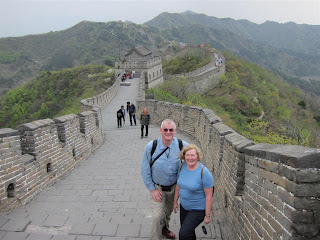Today was our final day in Beijing so an early rise and packing, trying to fit our acquisitions into our already-bulging cases. The day looked full of promise because it was bright sunny again.
Our final outing was to the imperial summer palace on the outskirts of the city. On our way there we passed by Tiananmen and the Forbidden City one last time, observing that the Aussie flags were still up. Traffic past them was moving at a snail’s pace however. Suddenly, after a traffic light, it moved smoothly again. Jeff explained that we had just passed the seat of government, which had imposed a rule that no traffic may move slower than 60 km/h in front of the entrance. They just bunch all the traffic up at the lights before the entrance and then sequence the following lights so that a large batch of cars can pass by swiftly. This is an interesting example of how the government controls the people.
The summer palace was home to the court from April through November. Apparently it reached its present state under the dowager empress Cixi (“seesee”) – a formidable woman. She liked to be there more than in the city.
The site is remarkable for the large artificial lake which Cixi had made because she wanted to be near water. The excavated earth was used to created a hill crowned with impressive structures. At the edge of the lake there is a concrete boat, anchored to the lake bottom, signifying that the dynasty, or China, is unsinkable.
The palace buildings were generally not that notable, but there were several exceptions. One was the theatre where we were treated to a performance of traditional music and dance. The other was a unique structure – the Long Corridor – a 760m long covered passageway decorated with 14,000!! individual paintings, all different.
While waiting to get on a dragon boat to take us back to the entrance, we came across a group of small school children. They were a lively bunch and interacted freely with us onlookers, practicing their few words of English. It was such a heart-warming thing to see.
On the to lunch we did a lightning stop by the side of the motorway, ascended a pedestrian overpass and had a quick peek at the Bird’s Nest and the Water Cube – two of the Olympic venues. I was pleased we could do this because I had wanted to see this remarkable structure in the flesh. Sadly, it is not used for sport now.
Unlike the previous two times, today Jeff asked us if we would like to see a tea ceremony. Naturally we indicated that we would and we are pleased that we did. A nice young woman (they are always nice young women!) explained and demonstrated aspects of the tea ceremony, encouraging us to sample four different types of tea. We were astounded to learn that there are more 2,000 types of tea in China. Puts the French and their 573 (my guess) types of cheese in the shade. At one point she place a ball thwo thirds the sizeof golf ball into a glass and then continued with her demonstration and sampling. Several minutes later she drew our attention to the glass. The ball had transformed itself, expanding from a small ball into a (real) camellia flower, in brilliant yellow – amazing. Because we are such good sports (suckers) we bought a pack of one of the teas we had tasted – ginseng ulong.
Lunch was at our guide’s bride-to-be’s favourite restaurant – a traditional (non-tourist) establishment. Here we had the best meal of our stay, this time joined by Jeff and the driver, a fitting way to end our stay. Finally we were whisked to the airport, where Jeff ensured that we were properly checked in before waving us good-bye.





















































